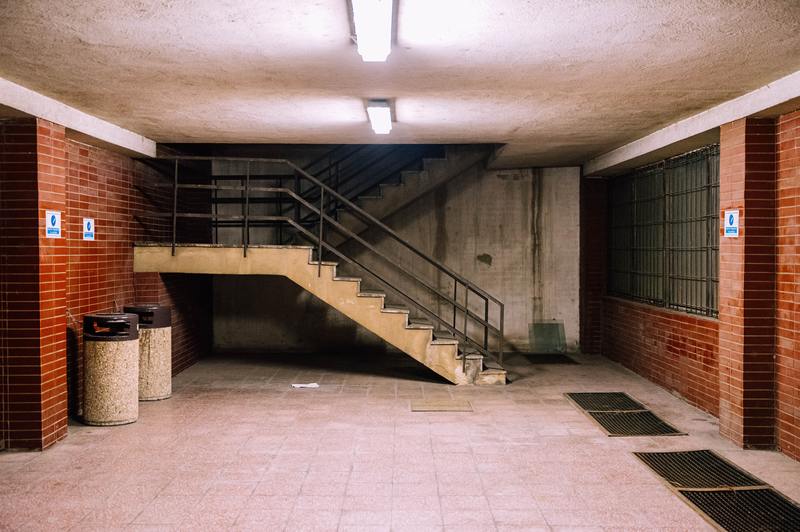Remove all the severely damaged areas, then use a cleaning agent to kill the fungus. This method is how to get rid of mold in basement settings.
Mold can be a pain; it looks ugly, smells terrible, and can even be harmful to your health! You need to remove every trace of it once you have an infestation.

Types Of Mold In The Basement
This fungus usually grows in the moist areas in your basement. The typical victims are wooden walls and floors, but other parts can also get contaminated. That’s why it’s also essential to learn how to clean water damaged wood bases.
You need to familiarize yourself with mold types so you know which ones are dangerous. Here is a list of them:
1. Aspergillus
This dark green mold is usually found on ceilings, walls, or furniture. It usually thrives in humid places, and it isn’t too dangerous for your health.
2. Fusarium
This yellow fungus grows in the wet parts of your basement. It releases mycotoxins which are detrimental to your health.
3. Stachybotrys
This black mold is one of the most dangerous contaminants in your basement. It has a strong smell that releases toxins into the air.
4. Cladosporium
This fungus thrives in cold weather, and you can usually find it on your windows.
How To Test For Mold
If you suspect an incoming mold infestation in your basement, then you need to have it tested.
- Surface test – You need to take a mold sample and send it to a laboratory for classification for this test. There are also some D.I.Y. kits available for sale.
- Air test – You use a monitor to check if any mold spores are floating around.
- Bulk test – You need to remove a small section of infested material and bring it to a lab for testing.
Causes Of Mold Growth In The Basement
Now you know the different mold types, but how did they grow in the first place?
Flooding
The stagnant water and damp surroundings are a perfect breeding ground for mold. Remember to follow the proper procedures if a floor happens in your basement.
Leaks
Subtle leaks are the worst; you don’t realize there’s damage until you discover a patch of mold. Make sure all your appliances and pipes are in good condition.
Humidity
Fungi thrive in humid areas, so if your basement is full of moisture, you need to invest in an exhaust system.
Step-By-Step Process On Removing Mold Infestation
Once you’ve discovered your little mold problem, you need to remove it. Cleaning will help reduce your risk of getting sick from the fumes. If you need help, here’s a guide on how to clean mold caused by water damage.
Step #1. Check your area
D.I.Y. is great, but your powers are limited. If you see that the infestation spans more than 10 square feet, you need a professional’s help. Dispose of all carpets, ceiling tiles, and other small furniture that are full of mold.
Step #2. Prepare your materials
Never forget your gloves, mask, and safety clothes. You will also need your cleaning agent; there are several home remedies you can use:
-
- Bleach – Combine one cup with a gallon of water
- Borax – Combine one cup with a gallon of hot water
- Phenolic detergents
-
- Essential oils (Eucalyptus, clove, lavender, tea-tree, or pine) – Mix 25 drops with a half cup of water and isopropyl alcohol)
- Steam
- Store-bought mold remover
Step #3. Ventilate the area
Open all parts of the basement, so there’s enough circulation. Free-moving air will lessen your chances of inhaling toxic fumes.
Step #4. Clear the basement
Remove everything that’s contaminated with mold. Dispose of carpets, cushions, and other decorations if they are too damaged.
Step #5. Clean the infestation
Apply your cleaning solution to the moldy area, leave it on for 15 minutes, then wipe it off with a paper towel. Repeat this cleaning as often as necessary.
Step #6. Dry the basement
When the mold is clear, leave the area to dry. Use a fan to help if necessary.
Step #7. Pinpoint the cause
Once you’ve cleared out all the fungi, determine what caused the mold to grow. Fix this problem so the mold doesn’t grow again.
How To Prevent Future Mold Growth
Now you’re done with cleaning the mold, how do you prevent it from coming back?
Clear out porous items
Basements are usually prone to being damp, so you should avoid installing carpets and unsealed wood. Don’t leave old paper lying around, either.
Regular maintenance
Constantly monitor the parts of your basement exposed to moisture, and clean the whole area as often as possible. Basement cleaning is part of your house cleaning routine.
Have proper ventilation
You must occasionally open your windows to let the air run freely. Install an exhaust fan if you feel it’s necessary.
Make the pipes leak-proof
Fortify the pipes and hoses in your basement, so they don’t cause any trouble.
Invest in a dehumidifier
This helpful device will remove the moisture from the air, discouraging mold spores from growing.
Conclusion
Your basement is a haven for all types of mold, and if you leave it unattended, it can cause a huge problem. You can protect your home and family when you know how to get rid of mold in basement, and remember to do suitable preventive measures. Now, everyone at home is safe.
